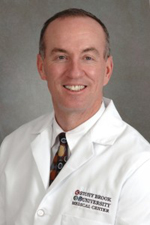Brian J. O'Hea, MD, associate professor of surgery and chief of breast surgery, and director, Carol M. Baldwin Breast Care Center, answers some of the most common questions women ask after they have been diagnosed with breast cancer.
The bottom line is that every woman’s situation is different, and treatment needs to be tailored to the type of cancer, personal and family history, tolerance levels for treatment and personal preferences.
Dr. O’Hea’s perspective, as one of the area’s premier breast cancer surgeons, gives women information to serve as discussion points with their doctors.
Q: What is a lumpectomy and is it safe?
A: A lumpectomy is the removal of a tumor from the breast along with some of the surrounding normal tissue. When a lumpectomy is recommended, many women consider whether a mastectomy might be a safer choice in terms of recurrence and survival. Longterm studies have demonstrated that a lumpectomy provides survival rates equivalent to a mastectomy while preserving the breast. A lumpectomy is often recommended to treat a single tumor that is small to medium in size. Patients with a large tumor or multiple tumors are often treated with a mastectomy. Also, the location, type of tumor and other factors all must be considered with your doctor when making this important treatment decision.
Q: Why do lumpectomies require follow-up radiation?
A: Even when lumpectomies show totally “clean” (cancer-free) margins after surgery, radiation is required because of the natural distribution pattern that breast cancer takes. Not all the cancer stays together. Some tiny, isolated cells may migrate to other parts of the breast beyond the scope of the surgery. This has nothing to do with the skill of your surgeon, but everything to do with the nature of breast cancer and how it manifests.
Q: If my lymph nodes are “clean” (cancer-free) following surgery, why would I need chemotherapy?
A: Think of chemotherapy as an insurance policy against future cancer. This form of treatment circulates a powerful drug or a combination of drugs through all parts of the body to kill any cells that may have floated away from the cancer site and lodged in other areas. Whether this actually happens depends on the characteristics of your tumor; some tumors can put women at a higher risk for scattered cells. This is why chemotherapy is the recommended precautionary measure.
Q: If my doctor recommends a mastectomy on just one breast, wouldn’t it be safer to have a bilateral mastectomy (removal of both breasts)?
A: Long-term studies show that there is a 15%t risk of a woman developing cancer in the opposite breast. However, women at higher risk may need to consider the bilateral mastectomy because their odds of developing cancer in the healthy breast are much higher. These risk factors include a strong family history of breast cancer and the presence of the BRCA gene, which indicates a genetic disposition to breast cancer.
Q: Are there any new options when it comes to reconstruction?
A: Fortunately, because of dramatic improvements in imaging and screening technology, we are more able to find cancer in its earliest stages, which offers some women an opportunity for breast conservation instead of mastectomy. At Stony Brook, 65% of the women treated for breast cancer have breast preservation surgery. Our surgeons work closely with plastic and reconstructive surgeons to maximize cosmetic outcomes.
Techniques include inserting AlloDerm®, a type of collagen, along with the tissue expander to give a more natural shape to the breast; smaller and more limited incisions that preserve as much of the natural breast skin as possible to facilitate a more natural reconstruction; and a new total skin- and nipple-sparing technique that leaves all of the breast skin in place, which also helps achieve the most natural result available. However, the nipple-sparing technique is possible in only a small group of highly selected patients requiring a mastectomy.
As an academic medical center and accredited Breast Care Center, Stony Brook works to continually refine techniques to make them more widely available for more patients.
Four Important Things Every Woman Can Do About Breast Cancer
1. Be scrupulous about scheduling annual screening mammograms and clinical exams after the age of 40.
2. Perform monthly breast self-examinations.
3. If you have a strong family history of breast or ovarian cancer, seek BRCA genetic testing. Once you know your risk, you can take preventive measures and risk-reduction steps that may prevent cancer from occurring.
4. If you are scheduled to have a surgical biopsy, inquire about having a needle biopsy instead. Core needle biopsy is the preferred initial breast biopsy method.
For more information about breast cancer treatment, call 631-638-1000.


